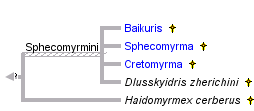Sphecomyrminae



This tree diagram shows the relationships between several groups of organisms.
The root of the current tree connects the organisms featured in this tree to their containing group and the rest of the Tree of Life. The basal branching point in the tree represents the ancestor of the other groups in the tree. This ancestor diversified over time into several descendent subgroups, which are represented as internal nodes and terminal taxa to the right.

You can click on the root to travel down the Tree of Life all the way to the root of all Life, and you can click on the names of descendent subgroups to travel up the Tree of Life all the way to individual species.
For more information on ToL tree formatting, please see Interpreting the Tree or Classification. To learn more about phylogenetic trees, please visit our Phylogenetic Biology pages.
close boxCharacteristics
Characters of the Sphecomyrminae basically conform to a primitive condition within ants (Bolton 2003). In contrast to all other ants (except for the Armaniinae), sphecomyrmines had short antennal scapes.Bolton (2003) divides the subfamily into two tribes, which differ in characters of the mandible, clypeus, ocelli, antennae, petiole, and abdominal segment III.
References
Bolton, B. 1994. Identification Guide to the Ant Genera of the World. 222 pp. Cambridge, Mass.
Bolton, B. 1995. A New General Catalog of the Ants of the World. 504 pp. Cambridge, Mass.
Bolton, B. 2003. Synopsis and Classification of Formicidae. 370 pp. Memoirs of the American Entomological Institute, Vol. 71. Gainesville, FL.
Dlussky, G. M. 1975. Semeistvo Formicidae. Pp. 114-122 in: Rasnitsyn, A. P. Vysshie Pereponchatokrylye Mezozoya. Trudy Paleontologicheskogo Instituta 147: 134 pp. [Russian]
Dlussky, G. M. 1983. Novoe semeistvo pozdnemelovykh pereponchatokrylykh - "promezhutochnoe zveno" mezhdu murav'yami i skolioidami. Paleontologicheskii Zhurnal 1983 (No. 3): 65-78. [Russian]
Dlussky, G. M. 1987. Novye Formicoidea pozdnego mela. Paleontologicheskii Zhurnal 1987 (No. 1): 131-135. [Russian]
Dlussky, G. M. 1996. Ants from Burmese Amber. Paleontologicheskii Zhurnal 1996 (No. 3): 83-89. [Russian]
Dlussky, G. M. 1999. Pervaya nakhodka formikoidov v nizhnemelovykh otlozheniyakh severnogo polyshariya. Paleontologicheskii Zhurnal 1999 (No. 3): 62-66. [Russian]
Dlussky, G. M. and E. B. Fedoseeva. 1988. Proiskhozhdenie i rannie etapy evolyutsii murav'ev. Pp. 70-144 in: Ponomarenko, A. G. Melovoi Biotsenoticheskii Krizis i Evolyutsiya Nasekomykh: 228 pp. Moskva. [Russian]
Grimaldi, D., D. Agosti, and J. M. Carpenter. 1997. New and rediscovered primitive ants in Cretaceous amber from New Jersey, and their phylogenetic relationships. American Museum Novitates 3208: 1-43.
Hölldobler, B. and E. O. Wilson. 1990. The Ants. 732 pp. Harvard University Press.
Wheeler, G. C. and J. Wheeler. 1972. The subfamilies of Formicidae. Proceedings of the Entomological Society of Washington 7: 1-108.
Wilson, E. O. 1987. The earliest known ants: an analysis of the Cretaceous species and an inference regarding their social organization. Paleobiology 13: 44-53.
Wilson, E. O., F. M. Carpenter, and W. L. Brown, Jr. 1967. The first Mesozoic ants, with the description of a new subfamily. Psyche 74: 1-19.
About This Page
Page copyright © 2004
 Page: Tree of Life
Sphecomyrminae.
The TEXT of this page is licensed under the
Creative Commons Attribution-NonCommercial License - Version 3.0. Note that images and other media
featured on this page are each governed by their own license, and they may or may not be available
for reuse. Click on an image or a media link to access the media data window, which provides the
relevant licensing information. For the general terms and conditions of ToL material reuse and
redistribution, please see the Tree of Life Copyright
Policies.
Page: Tree of Life
Sphecomyrminae.
The TEXT of this page is licensed under the
Creative Commons Attribution-NonCommercial License - Version 3.0. Note that images and other media
featured on this page are each governed by their own license, and they may or may not be available
for reuse. Click on an image or a media link to access the media data window, which provides the
relevant licensing information. For the general terms and conditions of ToL material reuse and
redistribution, please see the Tree of Life Copyright
Policies.
- First online 20 March 2004
Citing this page:
Tree of Life Web Project. 2004. Sphecomyrminae. Version 20 March 2004 (temporary). http://tolweb.org/Sphecomyrminae/22198/2004.03.20 in The Tree of Life Web Project, http://tolweb.org/





 Go to quick links
Go to quick search
Go to navigation for this section of the ToL site
Go to detailed links for the ToL site
Go to quick links
Go to quick search
Go to navigation for this section of the ToL site
Go to detailed links for the ToL site